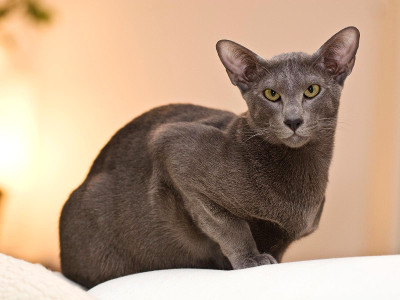Oriental Cat
Category: Cats

Facts about Oriental Cats, "Scientific name for Oriental Cat Felis Catus". The "Oriental Cat" respond to commands and human gestures with their loud, raspy voice.
Oriental Cats can see at levels of light six time lower than a human, this is why cats can catch mice so easily at night. Oriental Cats outer ear uses 32 muscles to control it, and a human has only 6 muscles in its ear and a cat can move its ears 180 degrees.
A Oriental Cat can move their ears independently. Oriental Cats on average sleep 13 to 14 hours a day and when they are awake, the spend a lot of time licking themselves to keep themselves clean. Oriental Cats help control rodents like small rats and mice where the live farm homes, warehouse, houses, ect. Oriental Cats are medium sized, weighing 5 to 10 pounds (2.2 to 4.5 kg ); the Oriental Cat makes a long time companionship with their favorite person in the family. The Oriental Cats are identical to the Siamese cats except for the color patterns.
The Oriental Cats love to be in the center of attraction and follow the family members everywhere. The Oriental Cat occupy the lap and share your bed forcibly. Even if the Oriental Cat is expelled out of the bed, you may find them sleeping in a corner of the bed while you get up. A Oriental Cats jaw can not move sideways, there for a cat can not chew large pieces of food. A Oriental Cats back is highly flexible because of its 53 loosely fitting vertebrae. The body of a cat has 230 bones. While a human body has 206. Compared to a humans who only have 34.
Personality
Oriental Cats are very chatty. Apart from their intense intelligence, the Oriental Cat impress their masters with their agility, fondness of sports and other athletic activities. The Oriental Cat take a little longer time to learn new things or to get along a new schedule, but once they are into it, you need not to worry about them. Even if you are going out and it might take few hours to return home, you can leave food for the Oriental Cat in their regular place so that they would eat it later. Habituated Orientals don’t consume the extra food once the time is gone.
Grooming
Oriental Cats have a pair triangular ears and a tubular body. The Oriental Cat have long slim legs, small and dainty paws. Their coat is mostly fine and silky. The Oriental Cat doesn’t need much grooming care except for weekly combing and a monthly brushing.
Oriental Cats are active and social pets and they are the perfect choice for a family with children and other cat friendly pets. Being attention seekers, the Oriental Cat enjoy the kind of touch, activities and importance children give to them. However, the Oriental Cat is advised to introduce pets to each other gradually in control circumstances to make sure nothing bad happens.
Cat Facts
There are over 500 million domestic cats in the world and 88 million in the United States Approximately 40,000 people are bitten by cats in the U.S. annually. A female cat is called a "queen or molly", male cat is called a "tom" and the name "clowder" is called a group and young or baby cats are called kittens.
Oriental Cats have very sharp hearing and their sense of smell is fantastic. Oriental Cats average life span is around 12 to 15 years. The reason why Oriental Cats can squeeze through very small spaces is that they have no collarbone and free-floating clavicle bones that their shoulders are attach to their forelimbs, that's why a Oriental Cat can fit through a hole the same size as its head and they use their whiskers to determine if they can fit through the space.
The cat's hairball is called a "bezoar" (meaning a concretion or calculus found in the intestines or stomach of certain animals, in particular ruminants, formerly alleged to be an effective cure for poison). A Oriental Cat can climb up a tree well but can not climb head first down a tree, because all the claws on a cat’s paw points the same direction, to get down from a tree, a cat has to back down.
A Oriental Cat can run at a top speed of about 30 mph (48.2 km) over a short distance. A cat rubs against a person to not only to be affectionate but also to mark out its territory. A Oriental Cat does not like water because its fur is not insulate it well when it gets wet.
A Oriental Cat averages about 12 whiskers on both side of its face. The average Oriental Cat temperature of a cat is 101.5 °F. The Oriental Cats heart beats at 110 to 140 a minute, That is almost twice as fast as a human heart. A Oriental Cats has 30 teeth while a kittens has about 26 teeth that they will lose at about 6 months of age. A Oriental Cat has the ability to jump up to six times its length.

 Back To Category Cats
Back To Category Cats